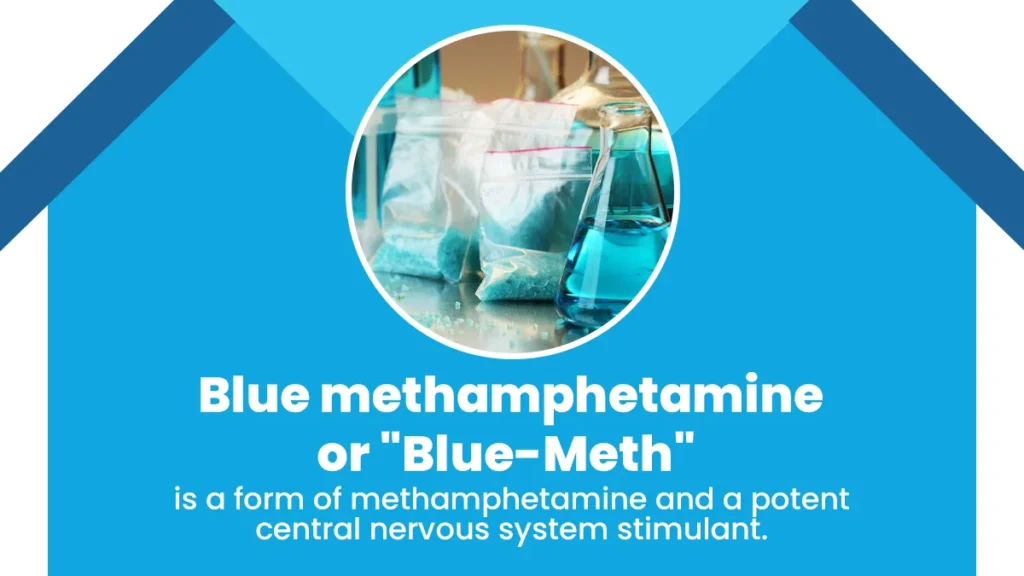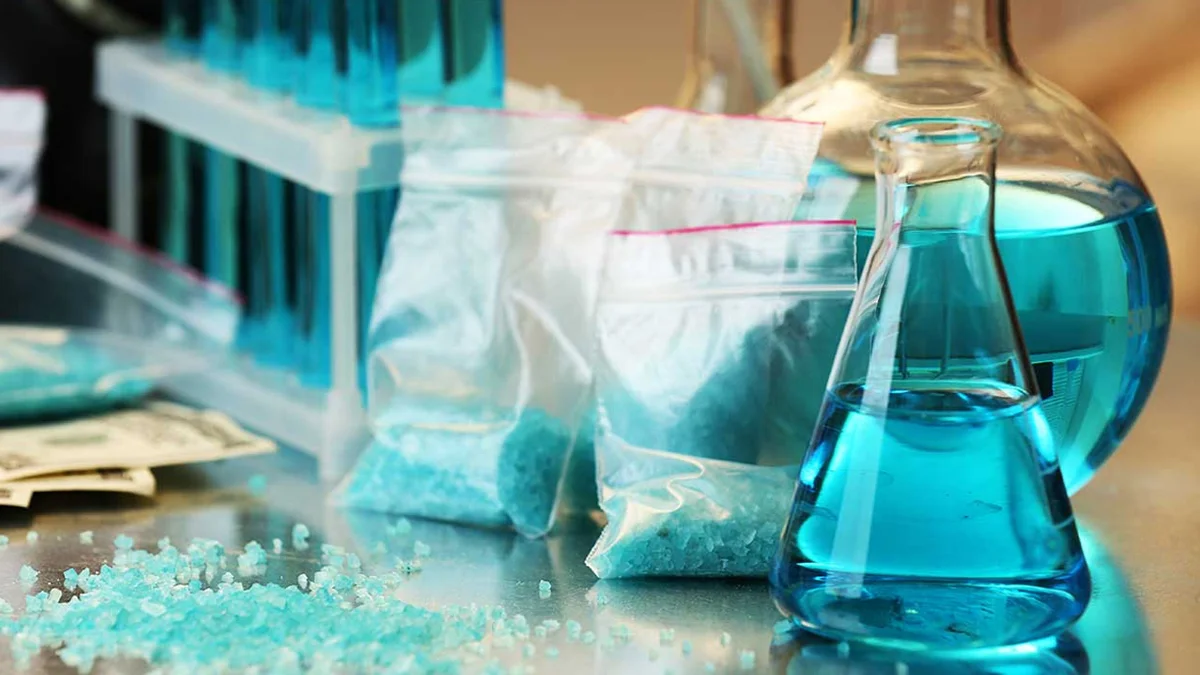Methamphetamine, commonly known as meth, is a powerful and highly addictive stimulant. Blue meth is a type of crystal methamphetamine that has a distinctive blue color. This coloring is usually due to additives or dyes and does not affect the drug’s potency.
Meth use is often glamorized, but the reality is far more dangerous and destructive. This article explores how the drug’s portrayal has influenced public perception and the complexities involved in treating meth addiction.
Key Takeaways
Blue methamphetamine’s emergence has raised concerns due to its societal impact and high potential for drug-related crime. Here’s what this article covers:
- Blue methamphetamine is a form of methamphetamine, a potent central nervous system stimulant.
- Health risks associated with blue methamphetamine use encompass both physical and psychological domains.
- Treatment options for methamphetamine addiction encompass behavioral therapies and counseling.
The Haven Detox-Little Rock offers medical assistance for lasting sobriety. Call us at (501) 271-3342 to discover more about our services.

Introduction To Blue Methamphetamines
Blue methamphetamine, often referred to simply as “blue meth,” gained widespread recognition through its portrayal in this popular TV series. Crystal meth is depicted as an exceptionally pure meth manufactured by the main character and his partner.
Methamphetamine itself has a longer history. It was first synthesized in the early 20th century and used during World War II to alert soldiers. In recent decades, meth use has surged, particularly in rural areas in the United States.
Rehabilitation from methamphetamine addiction presents significant challenges. Methamphetamine causes severe physical and psychological dependence. Long-term use often leads to important cognitive and emotional impairments, complicating treatment efforts.
Chemical Composition And Production
Methamphetamine is a powerful and addictive stimulant. Understanding the chemistry and production processes involved is vital in grasping its impact and risks.
Basic Chemistry Of Methamphetamines
The chemical formula of meth is C10H15N. It affects the central nervous system, increasing dopamine release in the brain. The basic structure includes a phenethylamine core, which is similar to other stimulants like amphetamine. Its potent effects are due to its ability to cross the blood-brain barrier quickly.
Specifics Of Blue Methamphetamine Production
The production of methamphetamine often involves synthesizing the drug from precursor chemicals such as pseudoephedrine or ephedrine, mainly in Southeast Asia. These precursor chemicals are typically sourced for both legal and illegal methamphetamine production.
The acquisition of chemicals is a crucial step in the methamphetamine manufacturing process. The blue coloring doesn’t indicate higher purity or potency but is added for aesthetic or brand differentiation.
Common Ingredients And Precursors
Methamphetamine is commonly synthesized using pseudoephedrine or ephedrine, found in cold medications. Other essential chemicals include anhydrous ammonia, lithium (from batteries), and red phosphorus. Household products like acetone, hydrochloric acid, and drain cleaners are also used.
Recognizing these aspects is a step toward mitigating its impact on individuals and society, emphasizing the need for education and intervention.
Risks Of Blue Meth
Understanding the psychological and physiological effects and health risks is important to realize the full concept of blue meth.
Cultural Appeal And Media Influence
TV shows often glamorize blue methamphetamines through a process called reductive amination. This portrayal attracts viewers and makes the characters appear exciting and powerful. It is particularly influential for teens and young adults, who might want to emulate the characters in real life despite the show’s depiction of negative consequences.
Psychological And Physiological Effects
Methamphetamine use triggers intense euphoria, increased energy, and heightened focus. Psychologically, it can cause paranoia, hallucinations, and aggressive behavior. Physiologically, users experience a rapid heart rate, high blood pressure, and reduced appetite. These effects are due to the drug’s impact on the brain’s dopamine system, leading to a cycle of addiction and dependency.
Health Risks And Long-Term Consequences
The health risks of methamphetamine use are severe. Short-term dangers include heart attacks, strokes, and violent behavior. High-dose use leads to negative side effects such as cognitive decline, memory loss, severe dental problems (meth mouth), and significant weight loss. Chronic users often face irreversible brain damage and an increased risk of mental health disorders.
While the media may glamorize the drug, the severe health consequences highlight the importance of awareness and prevention efforts.
Legal And Social Implications Of Blue Meth
The emergence of blue methamphetamine has sparked concerns due to its profound impact on society. Understanding its legal and social implications is key to addressing this issue effectively.
Laws And Regulations
Blue methamphetamine, like different forms of methamphetamine, is classified as a Schedule II controlled substance in many countries, including the United States. This classification means that it is highly regulated by law, its production, and distribution and is strictly prohibited without proper authorization.
Additionally, the vibrant blue color associated with this form of methamphetamine may lead to enhanced penalties due to its potential to attract users. Lawmakers may need to consider whether specific legislation targeting blue meth is necessary to address its production and distribution.
Impact On Communities
The presence of blue methamphetamine in communities can have devastating social and economic consequences. Its highly addictive nature not only harms individuals experiencing meth addiction but also destabilizes families.
The increased availability of blue meth may lead to a surge in drug-related crime, including theft, violence, and property damage. Further, it burdens law enforcement agencies and strains community resources. Communities already struggling with drug-related issues may face heightened challenges in addressing the unique risks posed by blue meth.
Law Enforcement Strategies
Law enforcement agencies employ various strategies to combat the production and distribution of blue methamphetamine. These include targeted investigations, undercover operations, and collaborations with other agencies to disrupt supply chains.
They also work to dismantle drug traffickers and drug dealers involved in drug trafficking. Additionally, community outreach programs aim to educate the public about the dangers of methamphetamine use and encourage reporting of suspicious activities.
Traditional approaches to combating methamphetamine production and distribution may need to be supplemented with specialized techniques. These processes should be tailored to the individual characteristics of blue meth.
In conclusion, the emergence of blue methamphetamine presents significant challenges for both legal authorities and society as a whole.
Treatment And Rehabilitation For Meth Use
Treatment and rehabilitation offer hope for recovery, providing support and resources to overcome addiction.
Available Treatment Options
Treatment for substance abuse usually involves a combination of behavioral therapies, counseling, and sometimes medication. Behavioral therapies, such as cognitive-behavioral therapy (CBT) and contingency management, aim to modify attitudes and behaviors related to drug use.
Counseling provides a supportive atmosphere for patients to address underlying issues contributing to their addiction. Another option is medication-assisted treatment (MAT), which involves using medicines to prevent cravings and withdrawal symptoms. However, MAT for methamphetamine addiction is still being researched, and there is no FDA-approved medication specifically for this purpose.
Challenges In Rehabilitation
Rehabilitation for methamphetamine addiction can be challenging due to various factors. One significant challenge is the intense cravings and withdrawal symptoms that people may experience when trying to stop using meth.
These symptoms can include depression, anxiety, fatigue, and intense cravings, making it difficult to stay sober. Additionally, methamphetamine use can cause long-term changes in the brain structure, affecting a person’s ability to experience pleasure and make sound decisions.
It may complicate the recovery process and require ongoing support and treatment. Social and environmental factors, such as stigma, lack of access to treatment, and exposure to triggers in the community, can also pose challenges to successful rehabilitation.
Remember, despite the challenges, treatment and rehabilitation offer hope for individuals struggling with methamphetamine addiction.
Frequently Asked Questions (FAQ)
Blue methamphetamines are a form of crystal methamphetamine that is blue. The blue color got hyped up when a popular TV show portrayed it as an indication of pure meth. However, color comes from additives or dyes and does not indicate higher purity or potency in real.
Methamphetamine is a powerful drug and highly addictive stimulant. It affects the central nervous system, increasing energy, focus, and euphoria. However, it also causes severe health issues, including addiction, dental problems, and mental health disorders. Blue meth is illegal and a dangerous drug. Its use and production are linked to serious legal and health consequences.
Using blue methamphetamines poses several health risks. It can lead to severe addiction and dependency. The drug can cause significant brain damage, affecting memory and cognitive functions. Cardiovascular issues are common, such as increased heart rate and high blood pressure.
Users may experience extreme weight loss and dental problems (“meth mouth”). Mental disorders like anxiety, paranoia, and hallucinations can occur. Chronic use may lead to severe skin sores and infections. Large amounts of meth may pose a serious risk, potentially resulting in death.
Blue coloring may indicate additional toxic substances, increasing these dangers. Overall, blue methamphetamines are extremely dangerous and harmful to both physical and mental health.
Pure methamphetamine typically appears as a white crystalline powder. However, the blue color is often associated with impurities or additives used in manufacturing, such as chemicals like iodine, methylene blue, or pseudoephedrine.
The blue hue can also result from improper synthesis techniques or contaminants. Pure meth itself is not naturally blue. Media representations may overstate or dramatize this aspect. However, encountering blue meth in real life suggests potential impurities or additives, indicating a higher risk of adverse health effects from substance abuse.
Refuge Of Sobriety: The Haven Detox-Little Rock
Struggling with meth addiction can be disturbing, but you don’t have to face it alone. At The Haven-Detox Little Rock, we provide the support and professional guidance you need to overcome this challenge.
Our detox services offer a safe and comfortable environment for withdrawal management, facilitating effective recovery. In the residential program, you’ll find a supportive community in a structured environment conducive to long-term sobriety.
IV therapy delivers essential nutrients and medications directly into the bloodstream, promoting physical healing during treatment. We also offer comprehensive mental health services for managing psychiatric issues.Embrace a new beginning, contact us at (501) 271-3342 for more information on our treatment services.




